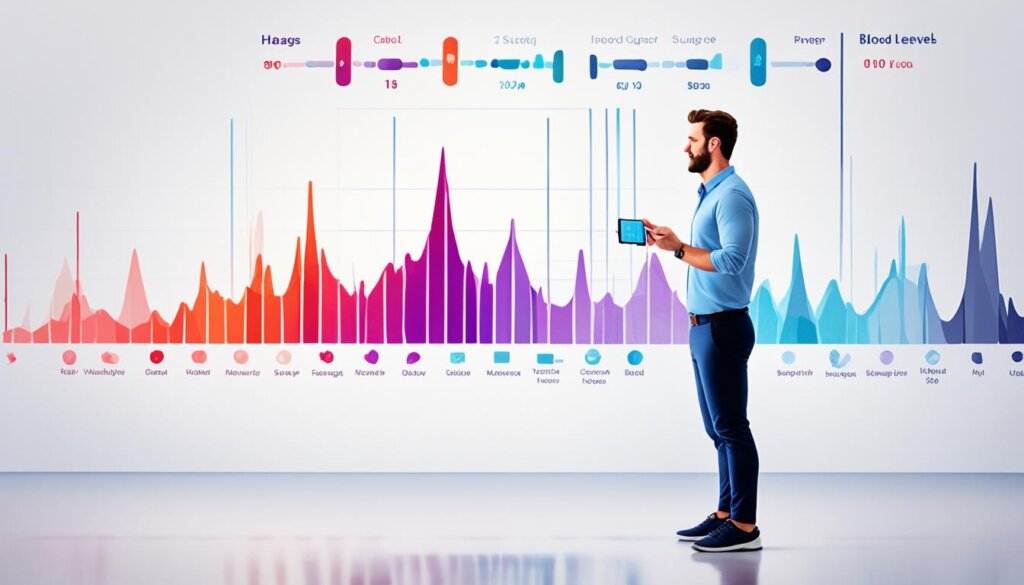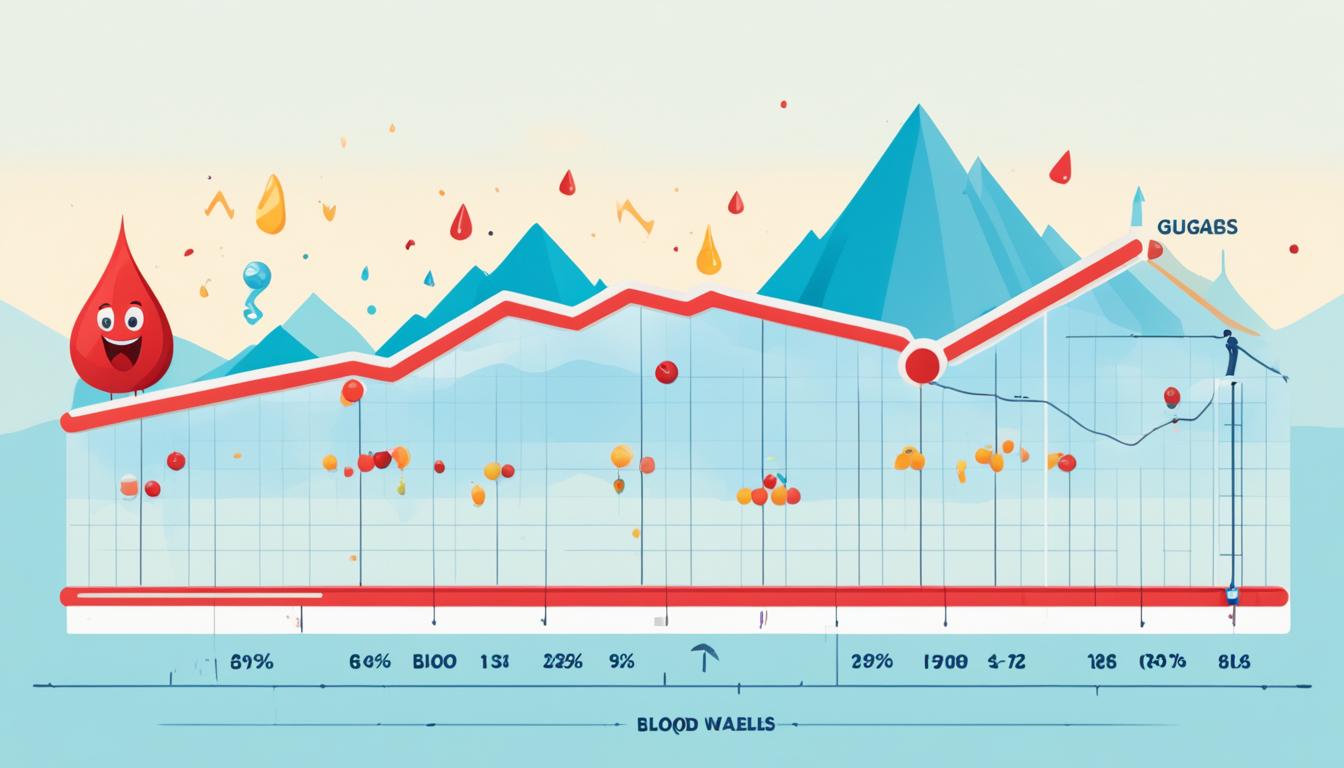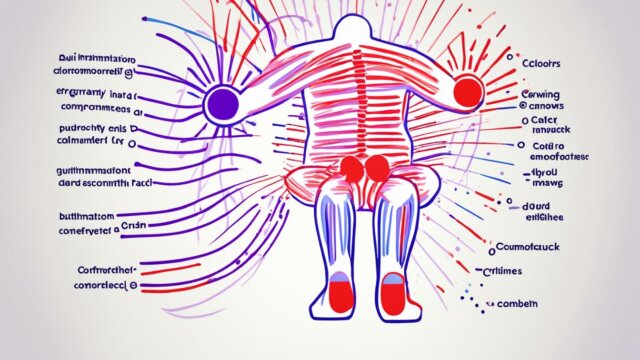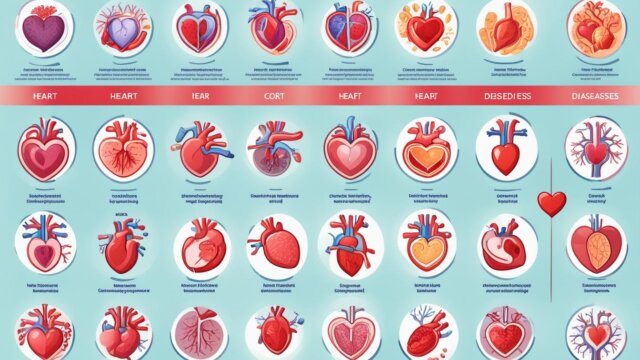FTC disclaimer: This post may contains affiliate links and we will be compensated if you click on a link and make a purchase.
Did you know 88 million American adults have prediabetes but 84% don’t know it? Keeping blood sugar levels healthy is key for your well-being. It affects your energy and long-term health. This guide will help you understand and manage your blood sugar for better metabolic health.
Glucose is the main energy source for your body’s cells. What you eat, especially carbs, turns into glucose. This glucose goes into your blood. Insulin, made by the pancreas, helps your cells use this glucose, keeping blood sugar levels right. But with type 2 diabetes, your body might not use insulin well, causing high blood sugar.
Key Takeaways
- Keeping blood sugar levels healthy is key for your health and avoiding serious problems.
- Checking your blood glucose often helps you see how things like food, exercise, and stress affect you.
- Working with your doctor to set blood sugar goals and manage them is important for your health.
- Knowing how blood sugar, insulin, and diabetes are linked helps you make better life choices.
- Tracking your blood sugar shows how well your diabetes plan is working and if you need to make changes.
Learning about blood sugar control helps you manage your health and avoid serious issues. This guide is for anyone with diabetes, prediabetes, or just wanting better metabolic health. It gives you the knowledge and tools to control your blood sugar and live a healthier life.
What is Blood Sugar?
Blood sugar, also known as glucose, is key to our health. It gives energy to our cells for many body functions. The pancreas helps control its levels by making insulin.
Glucose and Insulin: The Dynamic Duo
When you eat foods with carbohydrates, your body turns them into glucose during digestion. This glucose goes into your blood, making your blood sugar go up. The pancreas then makes insulin, helping the glucose get into your cells. As cells use the glucose for energy, your blood sugar goes back down.
But, with diabetes, the pancreas might not make enough insulin or cells can’t use it well. This is called insulin resistance. It can cause blood sugar levels to get out of balance, which is bad for your health.
“Keeping blood sugar levels healthy is key for our well-being. It affects our energy, mood, and long-term health.”
Knowing how glucose and insulin work together is the first step to managing your blood sugar levels. This helps keep you healthy.
Monitoring Blood Sugar Levels
Checking your blood sugar is key to managing diabetes. You can do this at home or with your doctor’s help.
Using a blood glucose meter is common. You prick your finger with a lancet and put a drop of blood on a strip. If you have type 1 diabetes, you might test 4 to 10 times a day. Type 2 diabetes patients who use insulin may test several times a day too.
There’s also the continuous glucose monitor (CGM). It’s a small sensor under your skin that checks your blood sugar every few minutes. This device sends the info to a device you can carry with you. CGMs show your blood sugar levels all day and night. They can also warn you if your levels are too low or high.
Your doctor might suggest an A1C test too. This test shows your average blood sugar over 2-3 months. It helps spot trends in your blood sugar control.
Monitoring Method | Frequency of Use | Key Benefits |
|---|---|---|
Blood Glucose Meter | 4-10 times per day for type 1 diabetes, several times per day for type 2 diabetes taking insulin | Provides immediate blood sugar readings |
Continuous Glucose Monitor (CGM) | Measures glucose levels every few minutes, 24 hours a day | Offers a comprehensive view of blood sugar fluctuations, can alert to low or high levels |
A1C Test | Every 2-3 months | Measures average blood sugar over an extended period, helpful for identifying patterns |
Using blood sugar devices right is key for getting accurate results. This means following the instructions, using the right blood sample size, and not using old test strips. Keeping track of your blood sugar, medicines, diet, and exercise helps your doctor make better treatment plans.

CGM devices can be not always accurate, so checking your readings with a finger-stick is a good idea. Also, check what your insurance covers for glucose meters and strips.
By watching your blood sugar, you learn how your body reacts to different things. This helps you and your doctor manage your diabetes better.
Ideal Blood Sugar Levels
Keeping blood sugar levels healthy is key for good health. The American Diabetes Association (ADA) and the American Association of Clinical Endocrinologists (AACE) set guidelines for blood sugar levels. For those without diabetes, levels should be between 72–99 mg/dL when fasting. After eating, levels should be under 140 mg/dL.
For people with diabetes, the ADA recommends levels of 80-130 mg/dL when fasting and under 180 mg/dL after eating. The AACE suggests levels less than 110 mg/dL when fasting and under 140 mg/dL after eating.
Levels below 100 mg/dL are normal. Levels between 100-125 mg/dL mean you might have prediabetes. Levels of 126 mg/dL or higher are diabetes. Keeping these levels in check is key for managing prediabetes and diabetes. It also helps prevent serious health problems.
Blood Sugar Levels | Normal | Prediabetes | Diabetes |
|---|---|---|---|
Fasting | 70-99 mg/dL | 100-125 mg/dL | ≥126 mg/dL |
2-Hour Post-Meal | Less than 140 mg/dL | N/A | ≥200 mg/dL |
Remember, blood sugar targets can change based on your age, diabetes duration, and other health issues. Always talk to a healthcare provider to find the right blood sugar targets for you. This helps keep your normal blood sugar levels in check and supports your health.

Hyperglycemia: When Blood Sugar Levels Are Too High
Hyperglycemia, or high blood sugar, is a serious condition that can lead to big problems if not treated. Many people don’t feel the effects of high blood sugar until it hits 250 mg/dL or more. Levels above 180 to 200 mg/dL usually don’t cause symptoms, but some people with type 2 diabetes might not show signs even when levels get very high.
Insulin resistance often causes hyperglycemia and is the main reason for Type 2 diabetes. About 1 in 10 people in the U.S. have diabetes, and being insulin resistant is a big reason for type 2 diabetes and high blood sugar. This can happen because of being overweight, not exercising enough, or taking certain medicines.
High blood glucose over time can make you less sensitive to insulin. This means your cells can’t take in as much glucose. If hyperglycemia isn’t controlled, it can cause serious issues like nerve damage, kidney disease, and heart problems.
Being sick, going through surgery, or getting hurt can raise blood sugar levels in people with or without diabetes. The dawn phenomenon also raises blood sugar in the morning, between 4 and 8 a.m. This happens because of hormone releases during the night.
Things like not using insulin right, not eating carbs at the right time, not taking enough diabetes medicine, being less active, and the dawn phenomenon can cause hyperglycemia in people with diabetes. Other things that can cause high blood sugar include not using insulin or diabetes medicine enough, injecting insulin wrong, not moving much, being sick, taking certain medicines, feeling stressed, getting hurt, or having surgery.
High blood sugar can lead to diabetic ketoacidosis (DKA), a severe condition that needs quick medical help. If your blood sugar is over 240 mg/dL and you have ketones in your urine, you need to see a doctor right away. In some cases, blood sugar can go over 600 mg/dL without ketoacidosis, causing a serious condition.
Long-term, high blood sugar can cause serious health problems like heart disease, nerve damage, kidney disease, eye problems, foot issues, bone and joint problems, and mouth infections. If you have high blood sugar for a long time, you might get infections, have trouble healing wounds, damage nerves, have vision problems, stomach issues, and harm to organs.
Early signs of high blood sugar include feeling thirsty, having headaches, feeling tired, and losing weight. If your blood sugar is over 130 mg/dL after not eating for 8 hours, it’s too high. After eating, if your blood sugar is over 180 mg/dL 2 hours later, it’s also too high.
Diabetes-related ketoacidosis can happen with very high blood sugar, causing dehydration, stomach pain, confusion, and even coma or death. High blood sugar can also lead to a condition called hyperosmolar hyperglycemic state, which can cause coma or death if not treated.
Things that increase the risk of high blood sugar include not taking your medicine right, being sick, hurt, stressed, or taking certain medicines. If you don’t control your blood sugar, it can lead to serious health problems like heart disease, nerve damage, kidney damage, eye problems, foot ulcers, and joint issues.
It’s important to check your blood sugar levels often to keep them in a healthy range and avoid problems. Checking your blood sugar levels is key to keeping them in a healthy range and avoiding problems.

Hypoglycemia: When Blood Sugar Levels Are Too Low
Hypoglycemia, or low blood sugar, is a serious issue for people with diabetes. It happens when your blood sugar drops too low. This can lead to serious problems if not treated quickly.
Recognizing and Treating Hypoglycemia
Early signs of hypoglycemia include tingling lips and trembling. You might also feel a pale face, sweat, have a racing heart, feel anxious, dizzy, or shaky. If your glucose drops too low, you could feel confused, disoriented, have seizures, or even pass out. This can be very dangerous.
To fix low blood sugar, try the “15-15” method. Eat 15 grams of carbs like juice, candy, or glucose tablets and wait 15 minutes. If your levels don’t go up, eat more carbs. In bad cases, you might need to use injectable glucagon to quickly raise your blood sugar.
It’s important to check your blood sugar often, especially if you’re at risk of hypoglycemia. Using a continuous glucose monitor (CGM) can help if you don’t feel symptoms when your blood sugar is low.

Dealing with low blood sugar quickly is key to avoiding serious issues. Always keep fast-acting carbs ready and know how to manage hypoglycemia.
Symptoms of Hypoglycemia | Causes of Hypoglycemia |
|---|---|
|
|
“Hypoglycemia can lead to complications such as dizziness, weakness, falls, injuries, motor vehicle accidents, and a higher risk of dementia in older adults.”
Diet and Exercise: Key Players in Blood Sugar Management
Your diabetes diet and lifestyle habits are key to managing your blood sugar. Eating a healthy, balanced diet with lots of veggies, fruits, whole grains, lean proteins, and healthy fats helps control your blood sugar. Try to eat less of the bad stuff like sugary foods and drinks, and avoid saturated and trans fats.
Being active can also help lower your blood sugar by making your body more insulin-sensitive. Even simple changes like using the stairs instead of the elevator can help. Keeping a healthy weight is also key for managing your blood sugar.
Recommended Physical Activity | Optimal Frequency |
|---|---|
Moderate Aerobic Activity | At least 150 minutes per week |
Strength-Building Exercise | 2 to 3 times per week |
For your diabetes diet, try the plate method for a balanced meal plan. You might need to count carbs and adjust your insulin if diet and exercise don’t lower your blood sugar enough.
Check your blood sugar before, during, and after exercise, especially if you’re on insulin or other diabetes meds. Don’t forget to drink plenty of water to avoid dehydration, which can affect your blood sugar. Know the signs of low blood sugar like shakiness and weakness, and act fast if you feel them.
“A balanced, healthy diet and regular exercise are essential for managing diabetes and maintaining overall well-being.”
By adding a diabetes diet and regular physical activity to your life, you can take charge of your blood sugar levels and boost your health.
Blood Sugar Levels and Diabetes
Understanding the Different Types of Diabetes
Diabetes is a complex condition that affects how your body manages blood sugar levels. It happens when your body can’t make or use insulin well. Understanding the different types of diabetes is key for managing and preventing it.
Type 1 diabetes is an autoimmune disorder where the body stops making insulin. Type 2 diabetes is the most common and is often a mix of not making enough insulin and not using it well. Prediabetes is when your blood sugar is higher than normal but not high enough for diabetes. Gestational diabetes can happen during pregnancy.
Knowing the unique traits of each diabetes type is vital for choosing the right treatment and lifestyle changes. This knowledge helps you manage your health and avoid complications.
“Diabetes is a chronic condition that requires ongoing management. Understanding the various types and their impact on blood sugar levels is the first step towards effective treatment and prevention.”
Glycemic Index and Load: Choosing Wisely
Choosing the right carbs can be tricky, but knowing about the glycemic index (GI) and glycemic load (GL) helps. The GI shows how a food affects your blood sugar, with scores from 0 to 100. Foods with a low GI cause a slow rise in blood sugar. High GI foods cause spikes. Medium GI foods are in between.
Lentils, beans, most fruits, and some veggies are great for low-GI diets. Whole-wheat bread, oatmeal, brown rice, and sweet potatoes are good for a medium-GI diet. Avoid white bread, white rice, sugary drinks, and pastries because they’re high-GI. Eating low-GI foods helps keep your blood sugar stable, which is good for people with diabetes or prediabetes. It also helps with weight control by making you feel full and reducing cravings.
The glycemic load (GL) looks at the GI and how much carbs you eat, giving a full picture of a food’s effect on your blood sugar. Adding protein or healthy fats to high-GI foods slows down sugar absorption. Also, eating smaller portions matters. Everyone reacts differently to foods, so try new things and see how your body feels.
Understanding the glycemic index and load helps you pick better carbs for your health.
Blood Sugar Levels: A Comprehensive Approach
Managing your diabetes management well means having a good plan. This plan includes checking your blood sugar often, either at home or with a monitor. You should also take any medication or insulin your doctor tells you to.
Eating right and staying active are key to keeping your blood sugar stable. Also, it’s important to manage stress because it can change your blood sugar levels.
Working with your doctor and using different strategies can help you control your blood sugar. This can lower the risk of diabetes problems. This full approach will help you reach your blood sugar goals and improve your health.
Metric | Target Range |
|---|---|
A1C | Below 7% |
Blood Pressure | Below 130/80 mm Hg |
Sleep | 7-8 hours per night |
Physical Activity | 150 minutes of moderate intensity per week |
Pre-meal Blood Glucose | 80-130 mg/dL |
Post-meal Blood Glucose | Less than 180 mg/dL |
Time in Range | At least 70% of the time |
By working with your healthcare team and using these tips, you can manage your blood sugar well. This can lower the risk of diabetes problems. Remember, a full plan is key to keeping your blood sugar in check and staying healthy.
“Diabetes management is a lifelong journey, but with the right strategies and support, you can achieve better blood sugar control and improve your quality of life.”
Conclusion
Keeping your blood sugar levels healthy is key, especially if you have diabetes. Knowing how glucose and insulin work together helps you manage your levels well. Knowing when your blood sugar is too high or too low is important. This can stop serious problems and make you healthier.
Using a mix of a good diet, regular exercise, and maybe medicine can help you control your blood sugar. Remember, preventing problems is important. By watching your glucose levels, you can lower your risk of chronic diseases and live a better life.
Learning about your blood sugar levels and acting to keep them healthy is a journey. By focusing on your health and using a whole approach, you can find better well-being and a brighter future.
FAQ
What is blood sugar and how does it work with insulin?
Glucose is a sugar that moves in your blood and is your main energy source. Foods with carbs make your blood sugar go up after you eat. Insulin, made in the pancreas, helps your cells take in glucose and lowers blood sugar.
How can I monitor my blood glucose levels?
You can check your blood glucose at home with a blood glucose monitor. This means pricking your finger and putting a blood drop on a strip. Or, you can use a continuous glucose monitor (CGM) that checks your blood sugar every few minutes and sends the info to a device.
What are the recommended blood sugar targets for adults with type 2 diabetes?
The American Diabetes Association (ADA) says your fasting blood sugar should be between 80-130 mg/dL. After eating, it should be less than 180 mg/dL. The American Association of Clinical Endocrinologists (AACE) suggests a fasting level under 110 mg/dL and less than 140 mg/dL after eating.
What is hyperglycemia and what are the symptoms?
Hyperglycemia means your blood sugar is too high. Signs include feeling thirsty, tired, seeing blurry, getting headaches, and needing to pee a lot. High blood sugar over time can cause serious problems like nerve damage and heart disease.
What is hypoglycemia and how can it be treated?
Hypoglycemia is when your blood sugar is too low, which is a big deal for people with diabetes. Early signs are tingling lips, shaking, looking pale, sweating, racing heart, feeling anxious, and feeling dizzy. To fix it, eat 15 grams of carbs and wait 15 minutes. If not better, eat more carbs. In bad cases, you might need injectable glucagon.
How can diet and exercise impact my blood sugar levels?
Eating right, with lots of veggies, fruits, whole grains, lean meats, and healthy fats, can help control your blood sugar. Avoid too many carbs, sugary foods, and bad fats. Exercise makes your body use insulin better, which can lower your blood sugar.
What are the different types of diabetes and how do they affect blood sugar levels?
Diabetes comes in types like type 1 (no insulin), type 2 (insulin issues and insulin resistance), prediabetes (high blood sugar but not diabetes), and gestational diabetes (during pregnancy). Knowing these types and how they affect blood sugar is key to managing them.
What is the glycemic index and how can it help manage blood sugar levels?
The glycemic index (GI) shows how a food raises your blood sugar compared to pure glucose. High GI foods like candy and white bread cause a quick spike. Low GI foods like whole grains and fruits affect blood sugar more slowly. The glycemic load (GL) looks at both GI and carbs in a serving to better understand its blood sugar impact.








